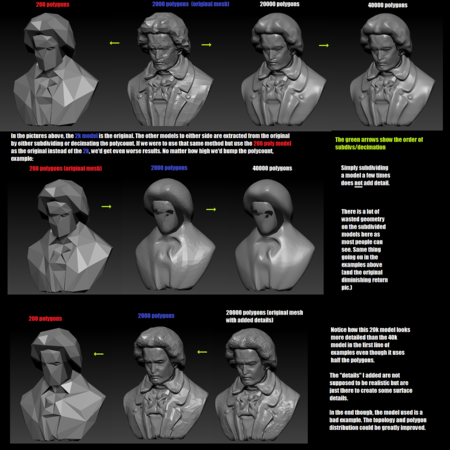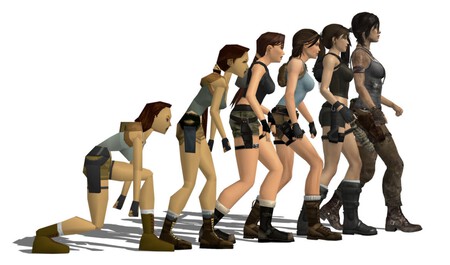Why XBSX and PS5 graphics no longer amaze us: Let’s talk about polygons and the law of diminishing returns

When a few days ago we talked about how Sony was going to manufacture more PS4s in 2022, a curious debate arose in the comments: many of you you criticized how, after all, the differences between the PS4 and the PS5 at a graphic level were negligible, and the same thing happened between the Xbox One and the new Xbox Series X.
That is certainly a truth as a temple, but the reality is that it was something to be expected: with each new generation of consoles the graphic jump has been less and less spectacular. The funny thing is that everything can explain an economic law of 1770 which applied to the world of computer generated triangles makes everything quite clear. But beware: that does not mean that the new generation of consoles is a fraud.
The more polygons the better? Not necessarily
The name of Adam Smith may sound familiar to you, considered the “father of capitalism” and who, for example, is repeatedly mentioned in the famous film ‘An amazing mind‘. This Scottish economist laid the foundations of modern economics, and one of the concepts with which he worked was the law of diminishing returns.

The summary is clear: there comes a time when having more polygons or triangles no longer makes much of a difference.
This law tells us about the decrease in the marginal income of production as a productive factor is added while keeping the others constant. What it basically says is that even if we gradually improve production processes, the improvements we will see in those processes will be smaller and smaller.

The theory was handled by various economists of the eighteenth century and although it is very focused on the field of production, it is also extensible to many other fields. Among them, of course, that of video games.
In fact it is something that we have experienced throughout the evolution of consoles: the jump from PS1 to PS2 was amazing. The one from the PS2 to the PS3 a little less. The one from the PS3 to the PS4 a little less still. The problem for many it is that the jump from PS4 to PS5 does not seem to be visually perceptible.
The same goes for the new Xbox Series S/X, whose games are no different in their graphic section from what was seen on the Xbox One. We no longer hallucinate with the new games in that section, because the graphics have certainly not experienced major changes in terms of their realism.
Only recent cases like the demo of ‘The Matrix Awakens’ seem to reveal that there is still room for manoeuvre, but not much or much less like the one that could be seen in jumps between previous generations.
It was something discussed eight years ago for example and Reddit: a graphic developer from Guerrilla Games —responsible for the saga’Killzone‘—explained how by then “we’ve stopped worrying about counting polygons”.
Already in 2006 the developers of Epic Games had shown how Going from a model with 4 million polygons to one with 9,000 polygons made little difference: The 9,000 polygon model was already detailed enough, and that was a clear advance of what we would end up seeing in the cross-gen jumps between consoles.
Today it is very difficult to make Lara Croft more realistic
En ExtremeTech They also talked about it and complained about how the graphics they expected from the new generation of consoles were not that great. Be careful: we are not talking about the PS5 or the Xbox Series X: they complained about the Xbox One and the PS4.

In fact, they made an interesting graphic representation of what had happened to the famous character of Lara Croft, one of those that allows us to visually verify how the jump from the protagonist of the first games to the one we have seen in the latest installments is amazing. The problem is that the jump between the latest installments is hardly surprising, and just seeing the complete evolution shows how far we have come (and how little we could win compared to the latest versions).

Even then, those editors believed that it was time to “focus on non-graphic features” and, for example, focus on the story that the game tells us or its artistic quality. We’ve certainly seen some of that in last-gen titles, but there are other things that give value to the new generation of consoles.
It is something that we talked about on other occasions and that I commented on my other blog. Playing better was not having better graphics, and those who have a PS5 or an Xbox Series X surely share the feeling that the owners of these consoles have: the games feel better.
Yes, they are the same games as always (or almost), but now we enjoy them in 4K at 60 PFS or in 1080p at 120 FPS, something that benefits even old remastered titles and that gain many integers with the change. Not only that: this new generation of consoles makes us wait much less: Ultra-fast SSD drives make loading times really short, which is much appreciated and makes a noticeable difference to the user experience.
It is of course expected that the hardware of these consoles will still give surprises at the graphic level, not perhaps at the level of detail —which is already spectacular in many cases— but rather in the possibility of enjoy larger, more detailed and more immersive worlds as we play. The law of diminishing returns has made us a little Easter, yes, but it was something that at this point we had to wait.
Reference-www.xataka.com